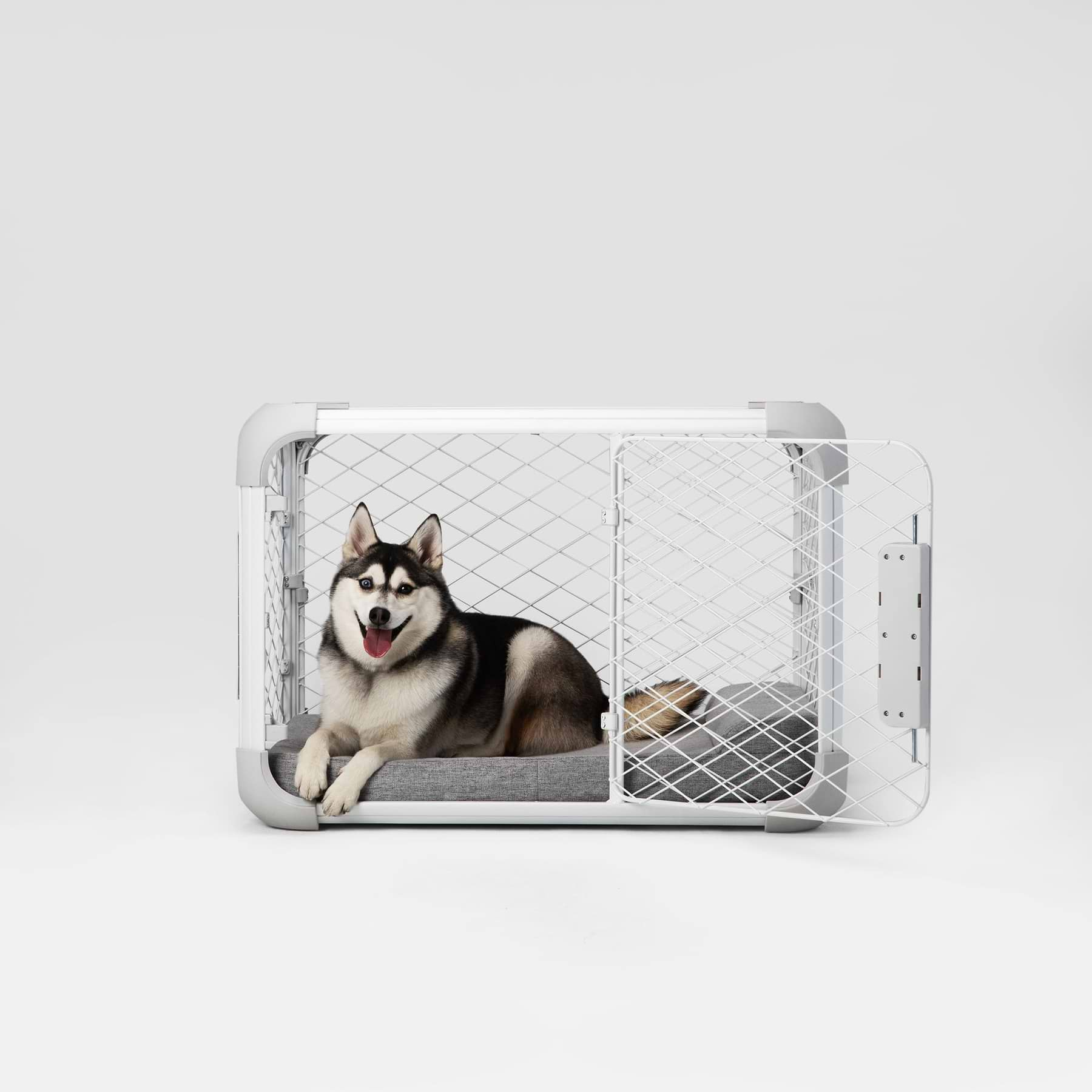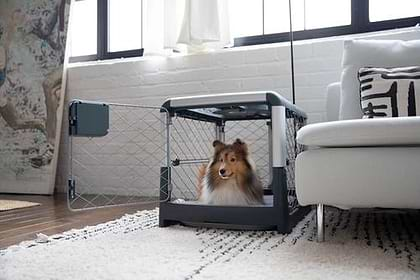What Does Destructive Crate Behavior Look Like
Before we get into the causes and prevention of destructive crate behavior, let’s take a quick look at how it presents itself. After all, you might not realize your pup is exhibiting these displays of destruction. Here’s what to look for:
- Chewing: Dogs may gnaw on the bars or wires of the crate, damaging them in the process. They might also chew on their bedding, toys, or any other objects within reach.
- Digging: Some dogs exhibit digging behavior inside the crate, attempting to dig their way out. This can result in torn bedding, scratches on the crate floor, and even injured paws.
- Escaping: Determined dogs may attempt to escape the crate by pushing, scratching, or chewing at the crate door or walls. This can lead to bent bars, broken latches, or even successful escapes.
- Vocalization: Dogs experiencing distress or anxiety in the crate may resort to barking, whining, or howling, expressing their discomfort and desire to be released.
Now that you know what to look for, let’s get into the most common causes for this kind of behavior.
Why Is My Dog Tearing up His Crate?
There can be several reasons why your dog is tearing up his crate. Understanding these causes is crucial for effectively addressing the behavior. Here are some potential reasons behind destructive crate behavior:
1. Separation Anxiety: Dogs with separation anxiety may resort to destructive behavior as a way to cope with their distress when left alone in the crate. Chewing and digging can be outlets for their anxiety.
Related: Check out our post, “Dog Crate Anxiety: 8 Ways To Reduce Anxiety”
2. Boredom or Excess Energy: If your dog doesn't receive sufficient mental and physical stimulation, he may become bored and resort to destructive behaviors to alleviate boredom or release pent-up energy.
3. Lack of Proper Crate Training: Insufficient or improper crate training can lead to confusion and anxiety in dogs. If they haven't been taught to associate the crate with positive experiences and haven't learned to self-soothe and relax in the crate, they may resort to destructive behaviors. Learn how to properly crate train your dog in this post.
4. Fear or Stress: Dogs may tear up their crates when they feel scared, stressed, or overwhelmed. This could be due to loud noises, traumatic experiences, or feeling trapped or confined.
5. Teething or Dental Issues: Puppies or dogs going through the teething phase may chew on their crates to relieve discomfort. Additionally, dental problems or pain can lead to destructive chewing behavior.
You may also want to consult with a veterinarian or professional dog trainer to determine the specific underlying cause of your dog’s destructive crate behavior. This will help you to better implement targeted strategies and interventions to address the issue effectively.
How Do You Stop Destructive Crate Behavior?
Stopping destructive crate behavior requires a combination of strategies and consistent training. A few of the ideas your vet and/or a dog trainer may suggest include, but aren’t limited to:
Proper Crate Re-Introduction
Re-introduce the crate gradually and make it a positive and comfortable space for your dog. Use treats, toys, and praise to create positive associations with the crate. Allow your dog to explore the crate voluntarily before closing the door.
Our Groov Training Aid is a great place to start. It encourages licking in lieu of biting which we’ve found can have a calming effect on your furry friend. And, if you don’t want to simply add peanut butter to it, we have a yummy treat spread that your doggo is sure to love!
It’s also important to have a comfortable crate for them to lay, stand, and play in. We recommend the Revol Dog Crate. Revol's rounded corners and paw-safe/jaw-safe mesh also make it a good option for dogs with destructive crate behavior. The mesh prevents pinching, and the rounded corners reduce the likelihood of injury from digging or shoving their paws or snouts into the corner.
Gradual Crate Training
Gradually increase the duration of time your dog spends in the crate, starting with short intervals and gradually lengthening them. This helps your dog become accustomed to being in the crate without feeling anxious or frustrated.
Busy with work, and not sure when you’ll have time to crate train your pup? This post might help!
Provide Mental and Physical Stimulation
Make sure your dog receives enough mental and physical exercise outside of the crate. Engage in interactive play, walks, and provide puzzle toys or treat-dispensing toys to keep your dog mentally stimulated and tire him out.
Use Chew Toys and Appropriate Bedding
Provide your dog with durable chew toys, such as Kongs or puzzle toys, to redirect his chewing behavior. Opt for sturdy bedding that cannot be easily torn apart.
Address Separation Anxiety
If separation anxiety is the root cause of the destructive behavior, consult with a professional dog trainer or behaviorist to develop a behavior modification plan that includes desensitization and counterconditioning techniques.
Related: Read our post Separation Anxiety in Dogs: Prevention & Training
Consider Crate Alternatives As a Last Resort
If your dog consistently exhibits exceptionally destructive behavior in the crate, you might need to consider using alternatives such as a playpen or a dog-proofed room with appropriate confinement measures to ensure your dog's safety and minimize destructive behavior.
Remember, consistency and patience are key when addressing destructive crate behavior. It's important to provide positive reinforcement, set your dog up for success, and gradually work towards longer periods of crate time while addressing any underlying issues contributing to the behavior.
Crate Training Tips
Here are some crate training tips for a positive and successful experience:
- Start early with crate training to familiarize your dog with the crate from a young age.
- Use positive reinforcement, such as treats and praise, to create a positive association with the crate.
- Introduce the crate gradually, allowing your dog to explore and feel comfortable at their own pace.
- Progressively increase crate time, starting with short periods and gradually extending them.
- Never force or punish your dog with the crate, as it can create negative associations.
- Create a comfortable environment inside the crate with appropriate bedding and size.
- Consider using calming aids, like pheromone sprays or soothing music, to help your dog relax in the crate.
- Practice patience throughout the training process, celebrating small successes.
- Gradually increase alone time in the crate to build independence and confidence.
- Maintain consistency in crate training by establishing a routine and expectations.
With the help of these tips, you can ensure a positive crate training experience for your dog, where they view the crate as a safe and comfortable space.
Commonly Asked Questions
Let’s wrap up this post with some of the frequently asked questions we see about destructive crate behavior.
Why is my dog tearing up his crate?
Dogs may tear up their crates due to separation anxiety, boredom, lack of proper crate training, fear or stress, teething, or dental issues. Understanding the underlying cause is crucial for addressing the behavior effectively.
How do I get my dog to stop chewing on his crate?
To get your dog to stop chewing on his crate, provide appropriate chew toys, discourage the behavior by redirecting to a toy, ensure sufficient mental and physical stimulation, and address any underlying anxiety or boredom.
What do you put in a dog crate that chews everything?
When dealing with a dog that chews everything in the crate, it's important to avoid putting anything that can be easily torn apart or ingested. Instead, opt for durable chew toys, indestructible bedding, or materials specifically designed for heavy chewers. It’s also a good idea to use a crate that can’t be chewed through. For example, the Revol Dog Crate is made with durable, high-grade aluminum, steel mesh wire and reinforced plastic and designed with baby industry standards – no more pinched paws or fingers - and much harder to chew through!
How do you stop destructive crate behavior?
To stop destructive crate behavior, focus on addressing the underlying causes such as separation anxiety or boredom. Implement positive reinforcement, provide mental and physical stimulation, gradually increase crate time, use appropriate chew toys, and consider professional guidance if needed.
How do you crate train a destructive puppy?
Crate training a destructive puppy requires patience and consistent training. Start with proper crate introduction, use positive reinforcement to create positive associations, gradually increase crate time, provide mental and physical stimulation, and address any underlying anxiety or boredom through behavior modification techniques. Professional guidance can also be helpful in managing a destructive puppy during crate training.
Get a Pet-Friendly Crate Today!
Understanding the causes and implementing effective strategies to prevent destructive crate behavior is crucial for the well-being of both dogs and their owners. By starting early, using positive reinforcement, providing a comfortable environment, and practicing patience and consistency, you can create a positive crate training experience that promotes a sense of security and comfort for your furry companion. With the right approach, and the right crate, destructive crate behavior can be a thing of the past. Click here to learn more about our Revol Dog Crates and Accessories.
You might also like
Crate training tips, stories and inspiration
View all blogsIn Your Diggs
Share your photos with #DiggsPet and tag us @DiggsPet on IG and TikTok.



